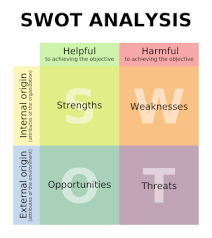SWOT Analysis
ArchIntel prides itself on being able to provide the best competitive intelligence research and analysis. From the collection of sources we investigate to the trends and conclusions we land on, our work stands strong and provides the insight you deserve when looking for competitive intelligence. SWOT analysis might be an introductory tool when it comes to competitive intelligence but that is no reason to discredit its ability to clearly compare and contrast company actions in a comprehensive, yet concise manner.
What is a SWOT Analysis?
A SWOT analysis is a strategic tool used to evaluate the overall operations of a company, usually in the planning process before a big shift in a company. This process is accredited to business theorist Albert S. Humphrey, who popularized it during his time at the Stanford Research Institute. In the decades since, it has become a staple of competitive business planning and strategic operations.
SWOT stands for Strengths, Weaknesses, Opportunities, and Threats. These four categories make up all areas of interest that a company’s operations will cover, comparing their success to their competitors and their industry at large.
Every company has pros and cons to how they operate their business and every industry has pros and cons that determine motives for the companies that inhabit it. Sometimes these positives and negatives are obvious and points of pride or shame within that company or industry but other times these factors are not as obvious.
Hidden in plain sight, these benefits or detriments can only truly be realized when a SWOT analysis is conducted. Oftentimes, a company is so rooted in their habits that they are oblivious to changes or the simple fact that the way they have been doing things isn’t their best option for the current landscape. Likewise they may be taking for granted a tactic that is working and be quick to throwing it away at the enticement of a newer, flashier tactic; one that might not be as structurally sound in the long run.
The Components of A SWOT Analysis
The four components that make up a SWOT Analysis cover all characteristics of a business and their competitive environment. Whether it be obvious or obscure, it is of greater value to your business when all of these facts are laid out in one place.
SWOT- Strengths
Strengths are where you shine. Do you have the largest market share? Fastest distribution system? Most reliable customer services? Any component that makes your business stand out and are points of pride for your company should be showcased here. Everyone loves to talk about their positives and areas in which they are confident. This should be an easy section for any business to fill out.
It is also important to keep in mind the strengths that others view your company having. This might be a little harder to figure out but looking through third party sources such as news articles and consumer reports about your business are great places to start. A competitive intelligence report can also provide this information as our research offers insight from all areas of interest.
SWOT- Weaknesses
While everyone might like to talk about their strong suits, it’s often harder to get someone to genuinely reflect on what their weaknesses are. While this step can be awkward and sometimes embarrassing, it is vital to the SWOT process. You should not hold back and be as honest with yourself as possible. A company that can openly acknowledge and address their weaknesses is one that will be stronger in the long term.
A more positive way of looking at the Weaknesses section is to think of them as goals or desires. What are some things you wish your company could do better? Maybe you are seeing competitors succeed in areas you are not. While this step shouldn’t resort to just comparing your inadequacies with competitors, it should be a time where you really comprehend what gives your competitors some much of an advantage in certain areas.
SWOT- Opportunities
If spending too much time thinking about weaknesses has brought you down this step should be what brings you back into a hopeful and excited spirit. Opportunities are where you can acknowledge areas of interest you should head in the future. What is something no one in your industry is doing? Opportunities are based on external factors whereas strengths and weaknesses are based on internal factors.
Having a competency of what is happening around you is important to knowing what opportunities actually are. Maybe a new market has risen and you already have a strong distribution system set up ready to take it on. Maybe you have enough capital to look into acquiring a new business so that you can diversify your operations. Make sure to keep your strengths in mind as they often are what leads to actualizing these opportunities. Expansions, new product launches, and acquisitions can only happen if you have a strong system in place to back up these ideas.
SWOT- Threats
Like opportunities, threats are influenced by external factors. Unless you are dealing with something like corporate espionage, your workers and everything else at your company should be working to improve your business, not hurt it. Because threats are external it can often seem like they come from out of the blue, if you are not actively watching for them. One of the greatest offerings of competitive intelligence research is that it can point out threats and properly assess the severity of their actions.
No company is immune to threats and many long standing, highly regarded, companies have fallen or been badly hurt for simply underestimating a threat. If Sears can go from one of the biggest companies in America to bankruptcy, all for just failing to modernize and properly counteract threats, it can happen to any company. Knowing what your biggest threats are and how to take care of them before they become too big of a problem is the best way to ensure this will not happen to you.
Most threats don’t start as a high priority aggressor or a sign of the end; often they start as obscure and minuscule trends that can grow if left alone. Something like a new competitor or technology can start as a harmless fad that sometimes dies before it can attract real attention but that isn’t always the case. Rarely do companies stay at the top of their industry forever and the ones that do are able to do so by adapting to changing consumer habits and technological trends. By knowing what these threats are and how to minimize their impact you can insure a long lasting future for your company.
SWOT Analysis Template
Below you will find a SWOT analysis template that visualizes how you should view your company. When completing a SWOT analysis you should write out all areas of interest, placing them in their proper box. By laying out all of your strengths, weaknesses, opportunities, and threats on one chart you can start to see how they all fit together.
When looking at everything all at once you can see which strengths can lead to opportunities, which weaknesses might cause threats, and how your company presents itself overall. Are you someone who stands out and is ready to take on any challenge or are you someone threatened by their own weaknesses? This process can be a real eye opener for some companies but given the right assistance they can feel more confident in their future.

Why You Need A SWOT Analysis
Now that you know what goes into a SWOT Analysis you can see why so many companies have completed them in the past and continue to use them for decision making. Big decision making is the main driving force for completing a SWOT analysis but a good company completes them regularly in order to stay aware of the changes in their company and industry as a whole.
One of the biggest strengths of completing a SWOT analysis is running a SWOT analysis on a company that isn’t even your own. Whether this be a competitor, a company you are looking to acquire, the company you are about to merge with, the applicability of a SWOT analysis goes beyond personal reflection. A big part of our competitive intelligence process is utilizing SWOT analyses of your company, as well as your competitors, in order to get a better understanding of your industry as a whole.
A SWOT analysis should offer you more than just an outline of your company at any given point. It should offer you insight into what you are doing right and wrong, what to look out for and where to move next. It can be a great way to assess your goals and see what might be stopping you from achieving them. When performing SWOT Analysis on other companies it can give you clarity on who they are. If they are a competitor you can know how to size them up and if they are a collaborator or new partner you can get a chance to know them before you are even in direct communication. By staying informed your business can stay in control of the areas that you want and reach out for those not yet in your grasp.




